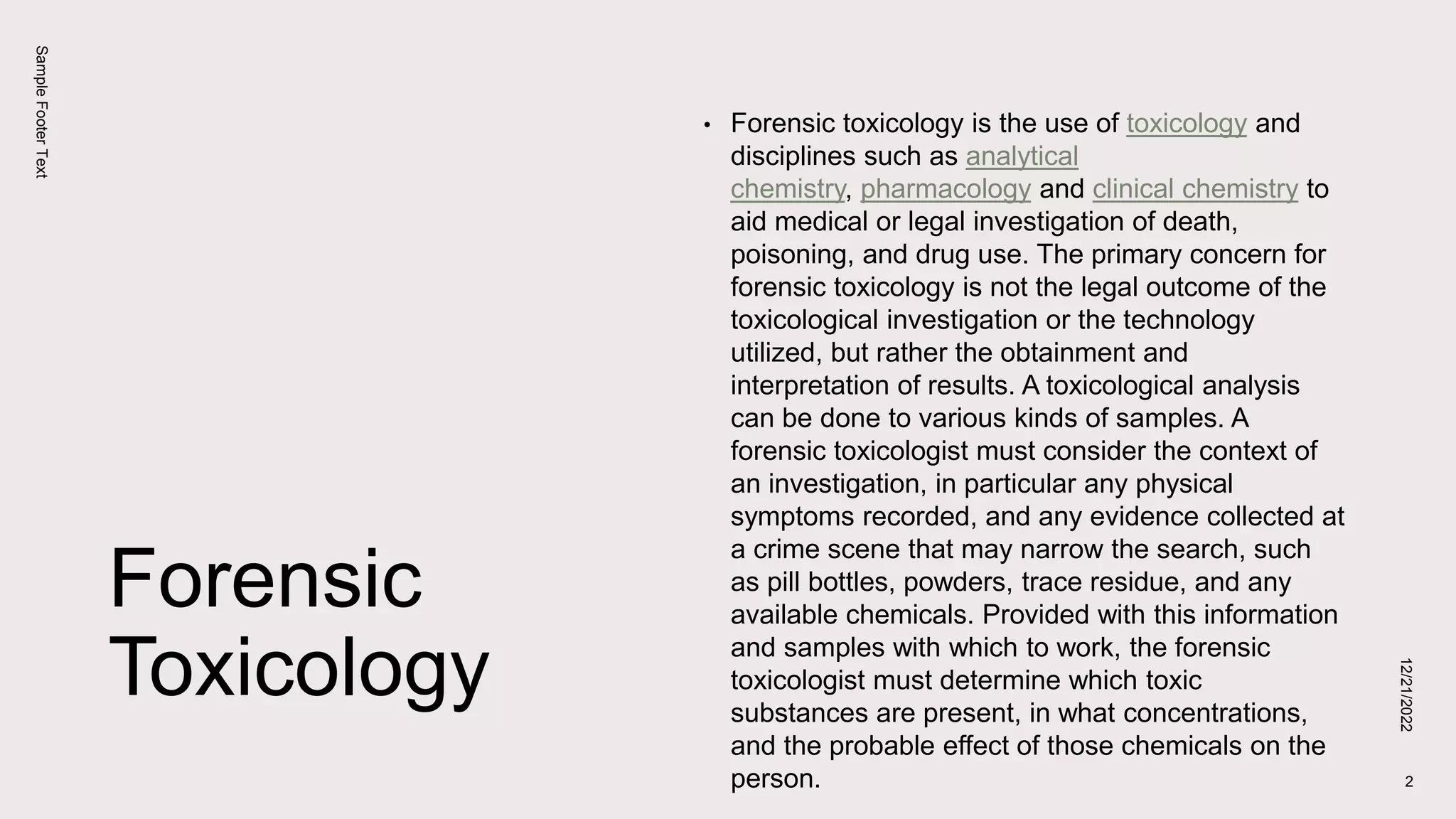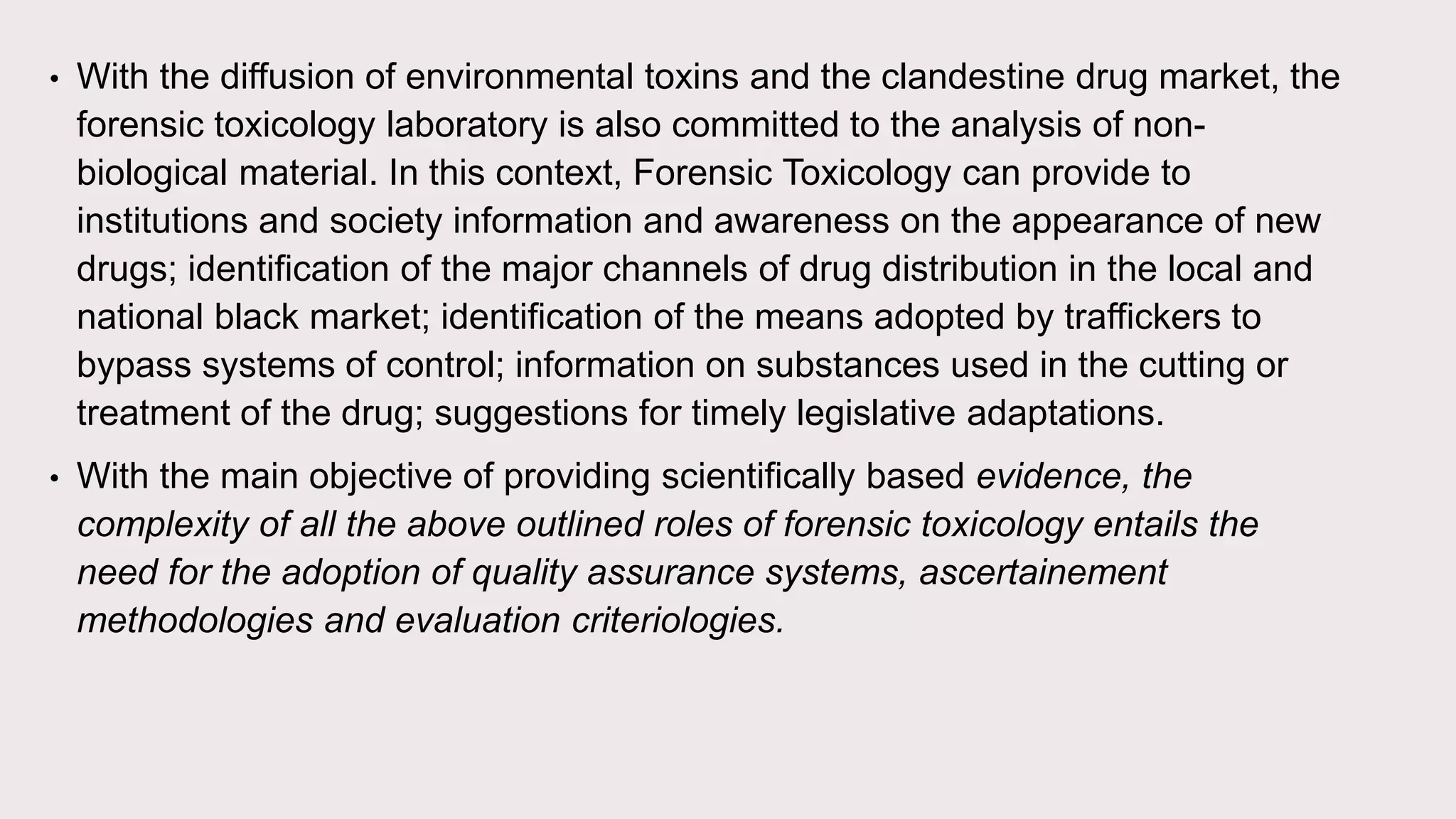Forensic toxicology uses analytical chemistry, pharmacology, and clinical chemistry to aid in investigations of death, poisoning, and drug use. A toxicological analysis can be performed on various sample types to determine what toxic substances are present, in what concentrations, and their probable effects. Forensic toxicology can be separated into postmortem toxicology, human performance toxicology, and forensic drug testing. Different analytical techniques like immunoassays, gas chromatography-mass spectrometry, and liquid chromatography-mass spectrometry are used to detect drugs and metals in samples.


![• forensic toxicology can be separated into 3 disciplines: Postmortem
toxicology, human performance toxicology, and forensic drug testing
(FDT).[3] Postmortem toxicology includes the analysis of biological specimens
taken from an autopsy to identify the effect of drugs, alcohol, and poisons. A
wide range of biological specimens may be analyzed including blood, urine,
gastric contents, oral fluids, hair, tissues, and more. The forensic toxicologist
works with pathologists, medical examiners, and coroners to help determine
the cause and manner of death. In human performance toxicology, a dose-
response relationship between a drug(s) present in the body and the effects
on the body are examined. This field of forensic toxicology is responsible for
building and implementing laws such as driving under the influence of
alcohol or drugs. Lastly, forensic drug testing (FDT) is the detection of drug
use among individuals in the workplace, sport doping, drug-related probation,
and new job applicant screenings.
12/21/2022
3](https://image.slidesharecdn.com/presentation1-221221170410-1e803770/75/FORENSIC-TOXICOLOGY-3-2048.jpg)
![How certain substances affect your body
• Alcohol
• Alcohol enters your central nervous system through the blood stream through the lining within your
stomach and your small intestine. Once it is in your blood stream, is passes through your blood
brain barrier via blood circulation. The alcohol absorbed will reduce your reflexes, interfere with
nerve impulses, prolong muscle responses, and affect other parts of your body as well.[5]
• Marijuana
• Marijuana, like alcohol, is also absorbed into the blood stream and passed through the blood brain
barrier. However, the THC that is released from marijuana attaches to the CB-1 cannabinoid
receptors which causes all of the affects that you experience. This include, but not limited to, mood
changes, altered perception of time, and increased sensitivity.[6]
• Cocaine
• Cocaine is a stimulant unlike Marijuana or Alcohol. As soon as cocaine enters the bloodstream it
reaches the brain in minutes. Dopamine levels are increased intensely and the effects can last up to
about 30 minutes. The most common way to use cocaine is by snorting it through the nose but
other methods could be by smoking it in a crystal rock form. But because dopamine levels are
increased at such a rate this leads to an even worse come down leading to needing a higher dose
to get the same effect as the time before if taken again. This is how some addictions begin. Some](https://image.slidesharecdn.com/presentation1-221221170410-1e803770/75/FORENSIC-TOXICOLOGY-4-2048.jpg)

![Examples
Urine
A urine sample is urine that has come from the bladder and can be provided
or taken post-mortem. Urine is less likely to be infected with viruses such as
HIV or Hepatitis B than blood samples.[8] Many drugs have a higher
concentration and can remain for much longer in urine than blood. Collection
of urine samples can be taken in a noninvasive way which does not require
professionals for collection. Urine is used for qualitative analysis as it cannot
give any indication of impairment due to the fact that drug presence in urine
only indicates prior exposure.[9] Different drugs can also stay in your urine for
different amounts of time. For example, alcohol will stay within your urine for
7–12 hours, cocaine metabolites will stay for 2–4 days, and morphine will stay
for 48–74 hours. One drug that will stay in your urine for a varying amount of
time (dependent on the usage and frequency) is marijuana. For a single use,
it will stay for 3 days, moderate use (4 times per week) will stay for 5–7 days,
daily use of the drug will cause it to stay for 10–15 days, and a long-term](https://image.slidesharecdn.com/presentation1-221221170410-1e803770/75/FORENSIC-TOXICOLOGY-6-2048.jpg)
![Blood
A blood sample of approximately 10 ml (0.35 imp fl oz; 0.34 US fl oz) is usually sufficient to screen and
confirm most common toxic substances. A blood sample provides the toxicologist with a profile of the
substance that the subject was influenced by at the time of collection; for this reason, it is the sample of
choice for measuring blood alcohol content in drunk driving cases.
Hair
Hair is capable of recording medium to long-term or high dosage substance abuse. Chemicals in the
bloodstream may be transferred to the growing hair and stored in the follicle, providing a
rough timeline of drug intake events. Head hair grows at rate of approximately 1 to 1.5 cm a month, and
so cross sections from different sections of the follicle can give estimates as to when a substance was
ingested. Testing for drugs in hair is not standard throughout the population. The darker and coarser the
hair the more drug that will be found in the hair. If two people consumed the same amount of drugs, the
person with the darker and coarser hair will have more drug in their hair than the lighter haired person
when tested. This raises issues of possible racial bias in substance tests with hair samples.[12] Hair
samples are analyzed using enzyme-linked immunosorbent assay (ELISA). In ELISA, an antigen must
be immobilized to a solid surface and then complexed with an antibody that is linked to an enzyme.
Bone Marrow
Bone marrow can be used for testing but that depends on the quality and availability of the bones. So
far there is no proof that says that certain bones are better than others when it comes to testing.
Extracting bone marrow from larger bones is easier than smaller bones. Forensic toxicologists use bone
marrow to find what type poisons used. These poisons can include cocaine or ethanol.](https://image.slidesharecdn.com/presentation1-221221170410-1e803770/75/FORENSIC-TOXICOLOGY-7-2048.jpg)




















